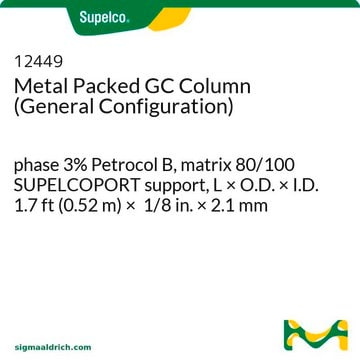214477
Silica gel Inorganic Sorbent
high-purity grade (Davisil Grade 923), 100-200 mesh
About This Item
Polecane produkty
product name
Silica gel, high-purity grade (Davisil Grade 923), pore size 30 Å, 100-200 mesh
klasa czystości
high-purity grade (Davisil Grade 923)
Poziom jakości
Postać
fine crystals
producent / nazwa handlowa
Davisil®
metody
LPLC: suitable
powierzchnia
430-530 m2/g
macierz
Silica
grupa aktywna macierzy
silica
wielkość cząstki
100-200 mesh
75-150 μm
wielkość porów
0.40 cm3/g pore volume
30 Å
tw
2230 °C
mp
>1600 °C
metoda separacji
hydrophilic interaction (HILIC)
ciąg SMILES
O=[Si]=O
InChI
1S/O2Si/c1-3-2
Klucz InChI
VYPSYNLAJGMNEJ-UHFFFAOYSA-N
Szukasz podobnych produktów? Odwiedź Przewodnik dotyczący porównywania produktów
Powiązane kategorie
Opis ogólny
a. Aquagel - pores are filled with water
b. Xerogel - by the process of evaporation, aqueous phase in the pores are removed
c. Aerogel - solvent removed by supercritical extraction
Zastosowanie
Przypis
Grade 923 meets ASTM D1319 specifications for hydrocarbon analysis
Informacje prawne
Kod klasy składowania
11 - Combustible Solids
Klasa zagrożenia wodnego (WGK)
nwg
Temperatura zapłonu (°F)
Not applicable
Temperatura zapłonu (°C)
Not applicable
Choose from one of the most recent versions:
Masz już ten produkt?
Dokumenty związane z niedawno zakupionymi produktami zostały zamieszczone w Bibliotece dokumentów.
Klienci oglądali również te produkty
Powiązane treści
Low pressure liquid chromatography (LPLC) operates at low pressures, using a pump to drive the mobile phase onto the column.
Niskociśnieniowa chromatografia cieczowa (LPLC) działa przy niskim ciśnieniu, wykorzystując pompę do wprowadzania fazy ruchomej na kolumnę.
Nasz zespół naukowców ma doświadczenie we wszystkich obszarach badań, w tym w naukach przyrodniczych, materiałoznawstwie, syntezie chemicznej, chromatografii, analityce i wielu innych dziedzinach.
Skontaktuj się z zespołem ds. pomocy technicznej



